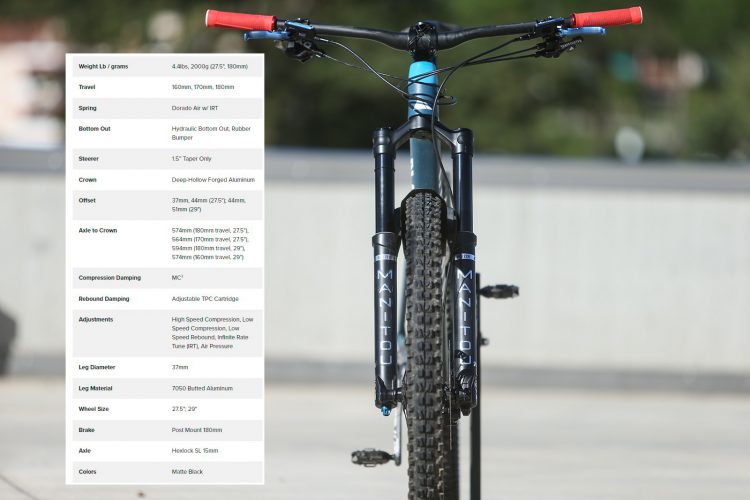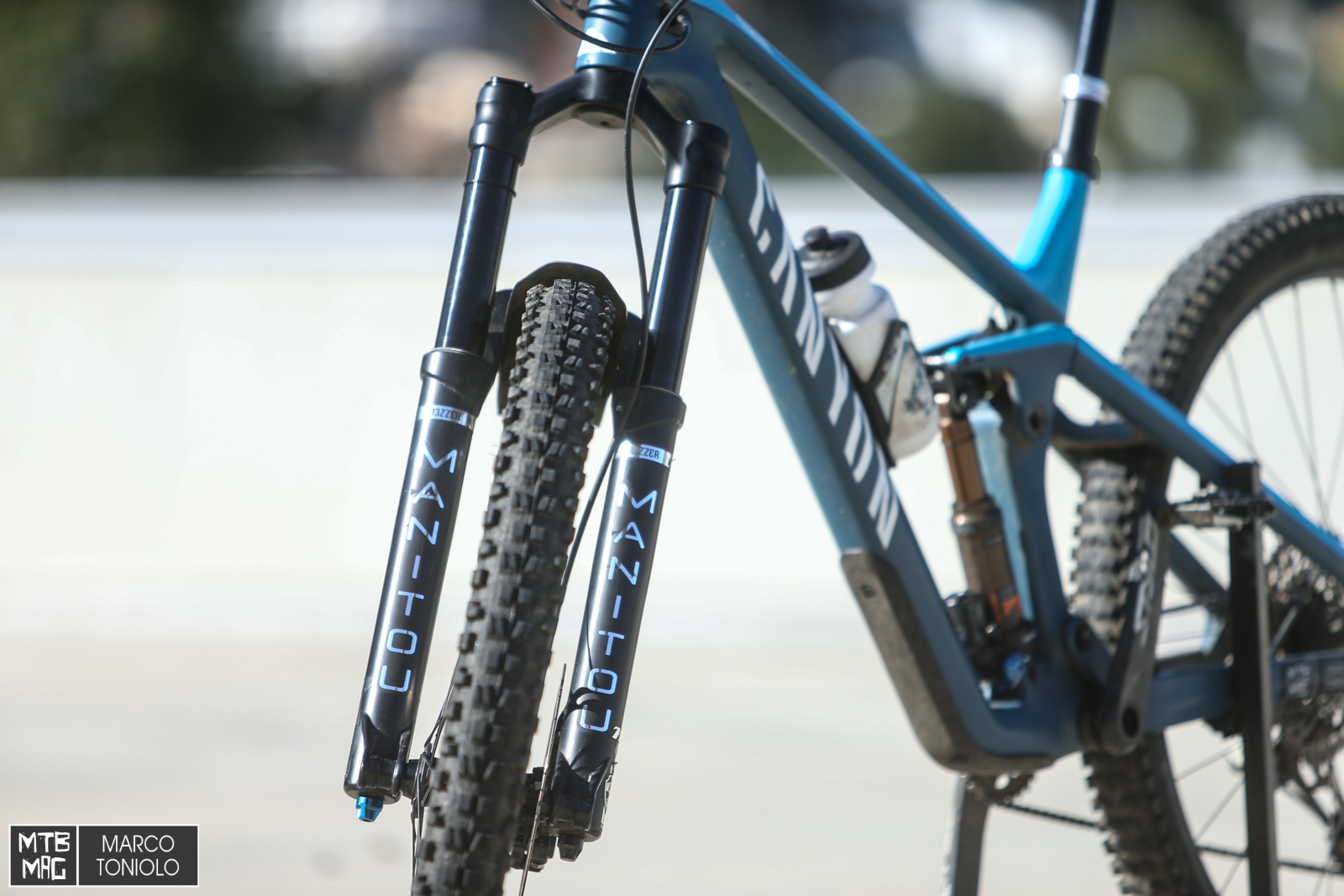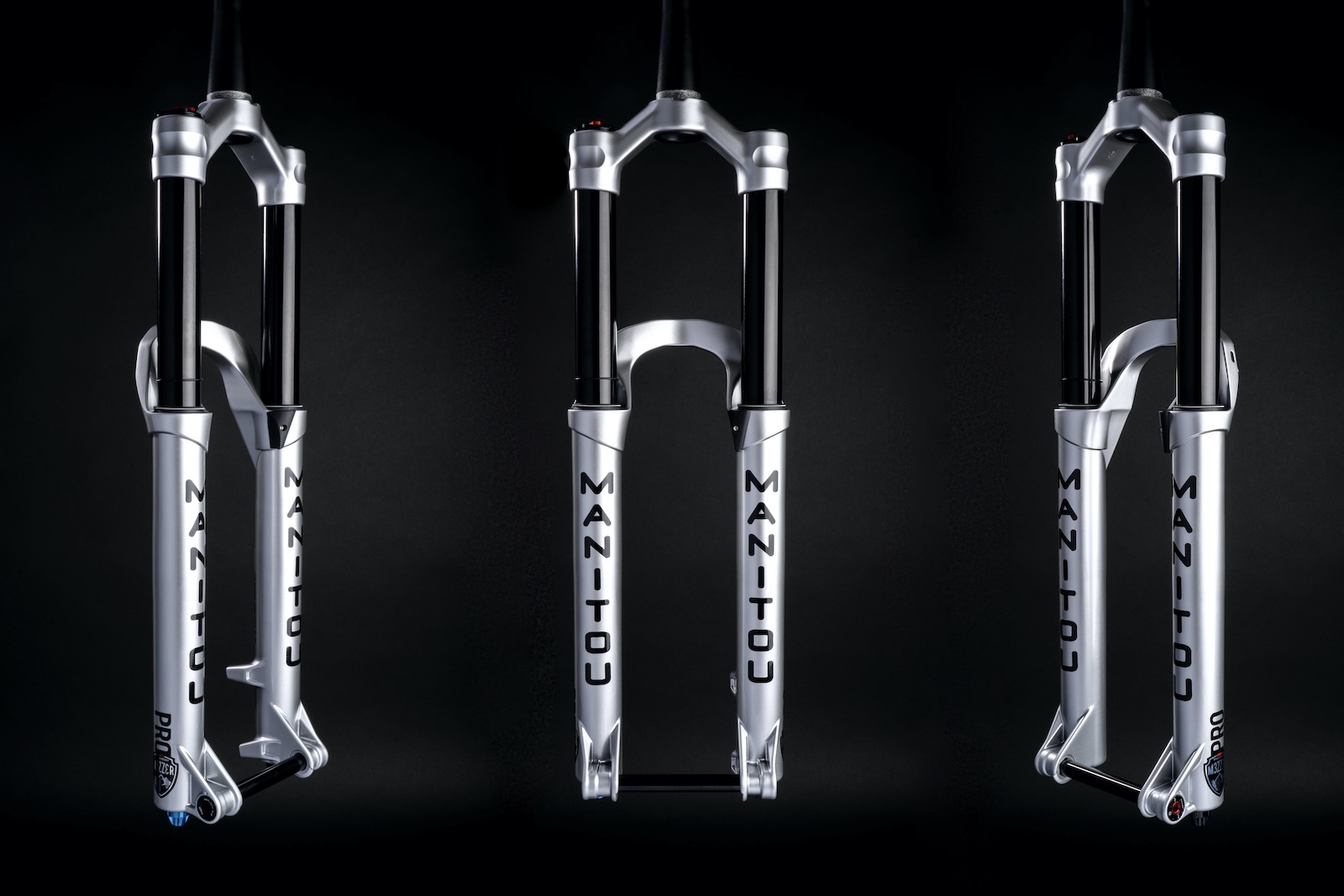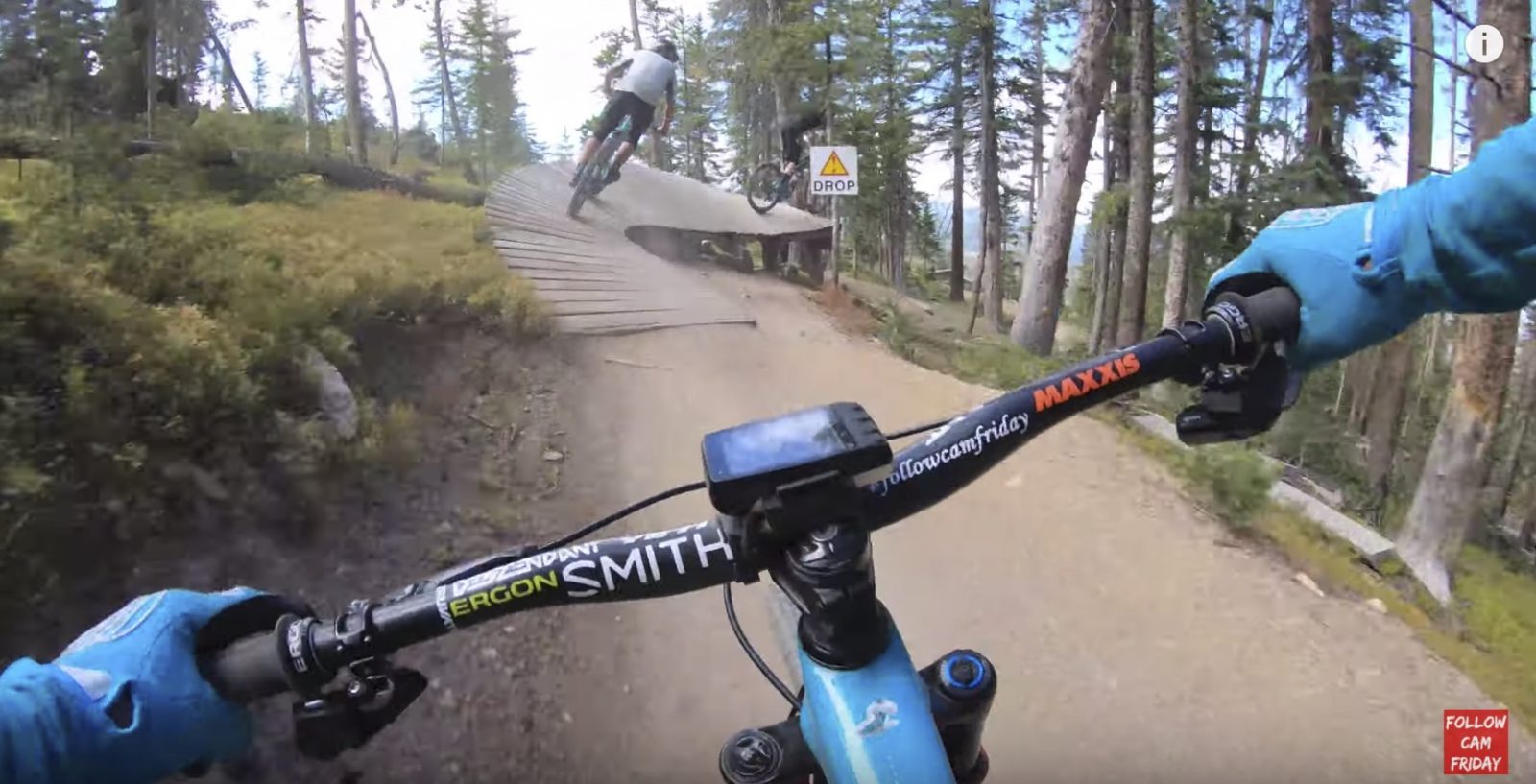First launched during the Riva bike festival, the Manitou Mezzer arrived for review at the end of June. Since then it has been mounted on both the Mondraker Foxy 29 and the Canyon Strive 29 for this season’s tests. After some solid time in the mountains, the has time come to take stock.
Presentation
I’ll refer to you on the beginning of May, where Manitou’s product manager explains in detail the intricacies of this fork.


Details (specific to the fork in test)
- Travel: 160mm
- Wheel diameter: 29″
- Stanchion diameter: 37mm
- Separate compression adjustments at high (4 clicks) and low (11 clicks) speed
- Rebound adjustment
- IRT (Infinite Rate Tune) for air spring curve tuning
- Hexlock SL 15mm thru-axle
- Mudguard included in the package
- Detected weight: 2.07kg
- Price: 1050 Euro
From an aesthetic standpoint, Manitou draws on their long tradition of placing the arch behind the fork legs. On the Mezzer every possible gram has been shaved, as you can see from the photo, in addition to creating space for the three screws needed to mount the mudguard. Regarding the fender, its shape protects the rider and the stanchions very well from splashes of water and mud. The dust wipers are grateful, that’s for sure.
The 37mm stanchions are immediately noticeable, really quite massive, as is the whole fork. A nice aggressive and burly look that meshes well with modern enduro bikes.
The 15 mm diameter HexLock SL thru-axle is not equipped with a quick release and instead, a 6 mm hex wrench is required for assembly / disassembly.
The axle is hollow opposite the insertion side and the inside is threaded. In the fork’s lower leg there is a second pin that’s threaded, much shorter and non-removable. That part screws into the main axle via a hex key and locks it down. The hexagonal sections of the thru-axle, on both sides, offer a nice solid fitment that improves torsional rigidity and is less prone to loosening. Installation/removal is obviously not quite as convenient as a QR, but it’s a small matter overall. Given how coarse the thread pitch is, it is also very difficult to damage things from over tightening.
The main air chamber valve is located at the base of the left leg, protected by a metal cap that screws onto the valve itself. When the pump is connected, the positive and negative chambers are charged simultaneously and balance themselves out.
On top of the left leg is the IRT valve, also protected by a cap.
The IRT works through a floating piston which creates a second chamber that works with the main one. This second chamber is to be charged with a higher pressure than the main one, according to the tuning table below. In uncompressed position it will get its maximum volume, then while when the fork is compressed and the pressure of the main chamber increases, its volume will gradually decrease. This way, it will build up resistance and progression, given that the air pressure contained in it will in turn increase. In essence it is like having a volume reducer (token) whose volume changes in accordance with the travel used.

Set up
The settings for the Mezzer are in reality quite simple: first the IRT chamber is inflated, then the main one, and finally the rebound and compression adjustments are made for the high and low speed circuits. Personally I found myself getting along very well with Manitou’s recommended settings. Weighing 70 kg without gear, I started with the values for a 73 kg rider. I inflated the IRT chamber to 84 psi and then the main one to 52 psi. This is the setting that Manitou defines as “enduro”, while for a more all around “trail” setting they suggest a 10 PSI reduction in IRT pressure and for more aggressive “downhill” riding, an increase by 10 psi. In the end the IRT adjustment that I preferred was the “enduro” one – a good compromise between initial sensitivity and supportive behavior on the steeps. I also had to find the right balance with the rear suspension as these things tend to go hand in hand.
The rebound is 5 clicks from closed, and high speed compression remained at 1 click from the fully open, with low speed at 4 clicks from open. I ran the sag at about 25%. One note: I usually leave the HSC on the faster side, to avoid getting brake pump and finishing a ride with swollen forearms. Relatively speaking, I prefer my suspension with a more “compliant” behavior, and also because I rarely ride bike parks with jumps, where you would want a bit more support.
On the trail
The Mezzer is not equipped with an actual lockout lever, so by default I always left it open uphill. I must say that at this point I am used to it, because neither the Fox 36 nor the RockShox Lyrik RC2 have one either. It is a matter of habit, in the end, it is enough to pedal without pretending to sprint uphill on asphalt, which is not what enduro bikes were designed for.
The first attribute that makes itself evident is the highly sensitive nature of the Mezzer when it comes to small chatter, thanks in part to the reduced operating pressures. The initial breakaway force required is minimal, thus the plush feeling. It took a surprisingly low figure of just 52 psi in the main chamber. This is a value that can only be reached with a system like the IRT, which starts to really kick in when the fork is halfway through the travel. Not only that, but the IRT is also responsible for the high progressivity at the end of travel, so much so that I’ve never been able to get a true bottom out. I’ve gotten close though…
Despite the chassis of the Mezzer appearing so burly, this is not a fork that beats up your hands and leaves them ringing at the end of long descent. The “comfort” from the suspension is also in large part due to its hydraulics and by how well the high speed compression behaves, never feeling “spikey”. Speaking of compression settings, I found the knobs didn’t make a big difference, actually the difference between open and closed was not easy to feel for both LSC and HSC. It’s worth noting that I rarely put fiddled with compression damping, because once the IRT was adjusted, I was more than satisfied with the behavior of the Mezzer, in particular on steep terrain and under heavy braking, when the rider’s weight is over the front of the bike.
Touching on small bump sensitivity: the traction and grip is really good, the wheel feels glued to the ground and it is easy to set and hold a line. Adding to this is the overall rigidity of the Mezzer, which contributes to its high precision steering. On more than one occasion I found myself picking straighter lines through rocks and slabs, instead of avoiding them, due to the confidence the fork provided.
During the test I also rode the Mezzer for a few days at the bike park, where it literally ate up the braking bumps. Despite the use and abuse over these last three months of testing, there are no signs of degradation or a loss of ride quality – it rides just as nicely as it did on day one.
Overall
It’s been a couple of years since Manitou introduced the IRT system: on the Mezzer it makes really a big difference, allowing the fork to work with low air pressures, which increases small bumps sensitivity and overall compliance. At the same time it makes the suspension curve really progressive at the end of the stroke, with the help of an hydraulic bottom out. The HSC and LSC setting differences through the external knobs are not that big, but honestly I didn’t feel the need to work on them a lot, because the Mezzer stays really high in the travel and it’s hard to bottom out. Its bulky chassis provides a lot of confidence on rough terrain and makes it easy to hold your chosen line in the corners.




















